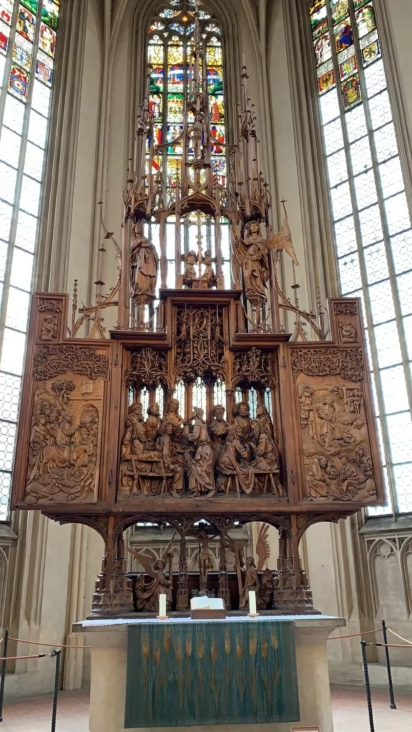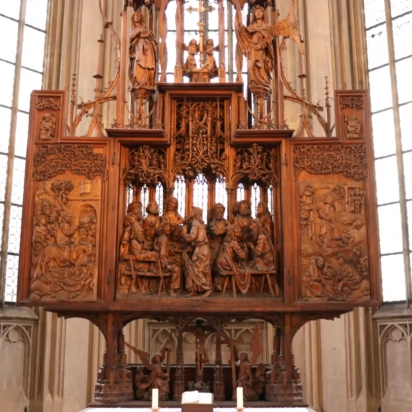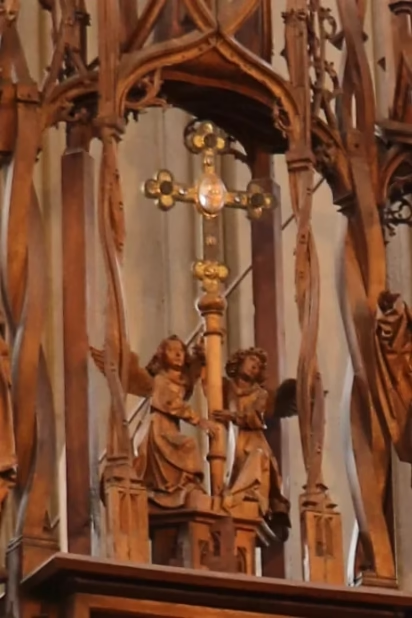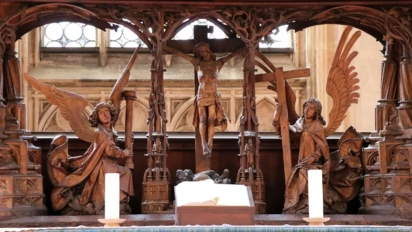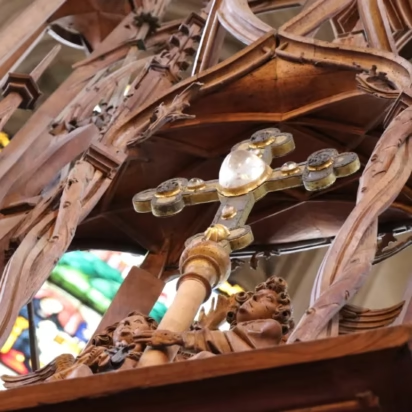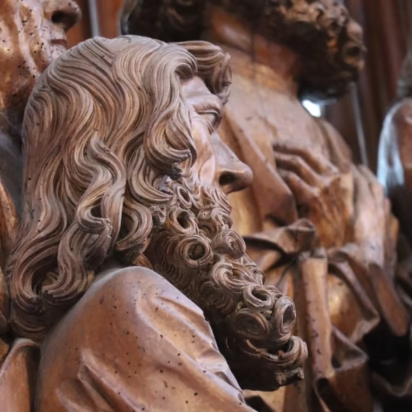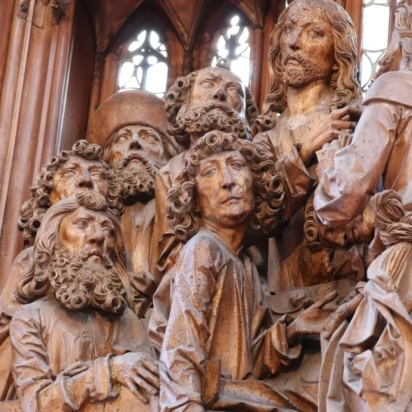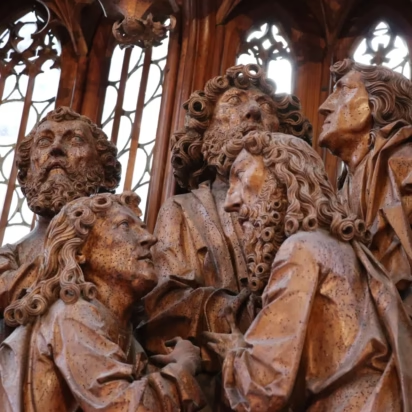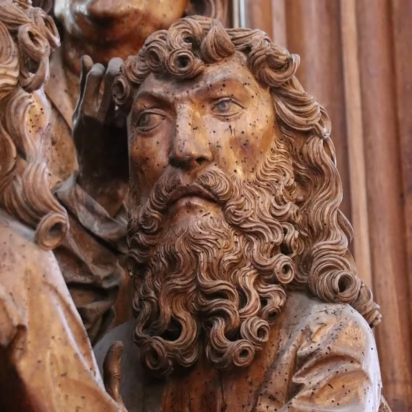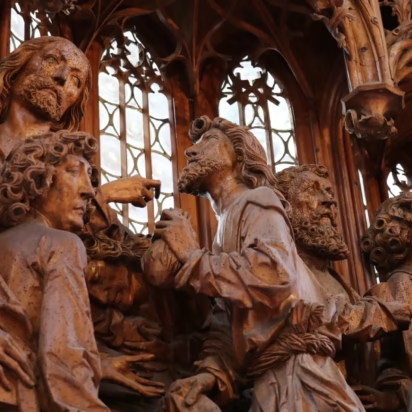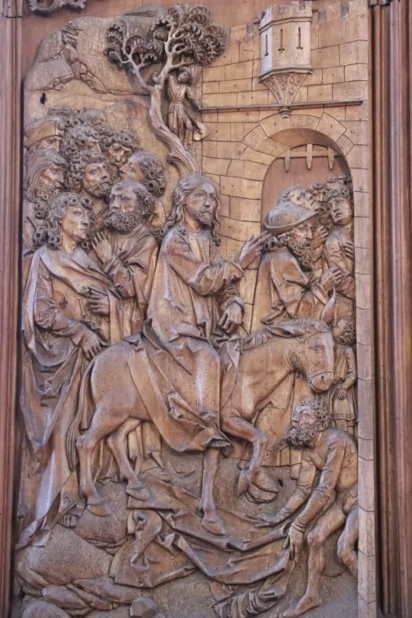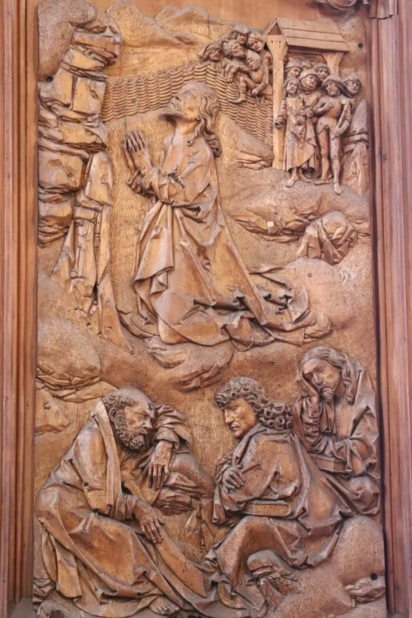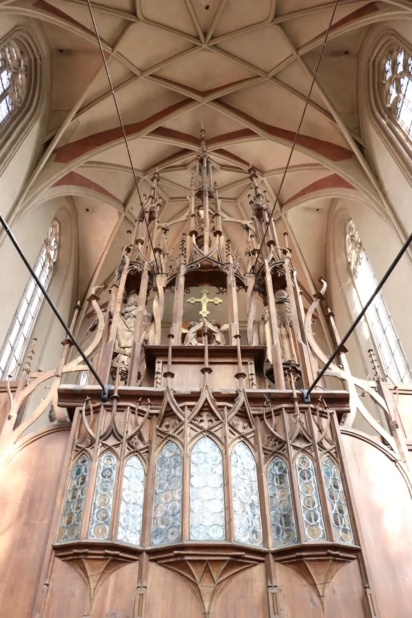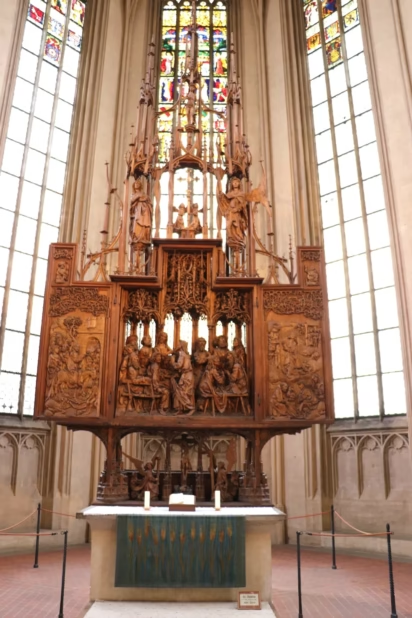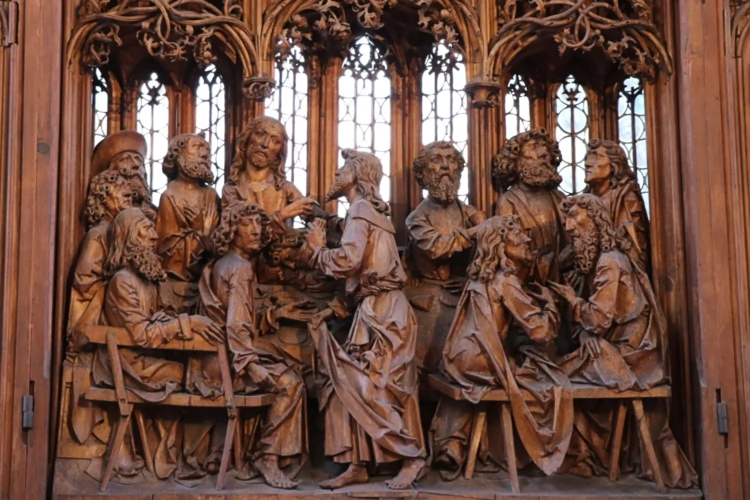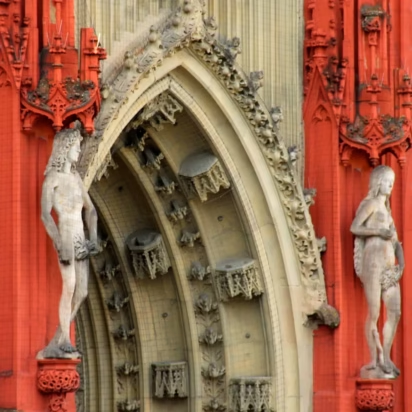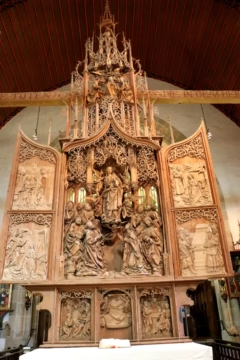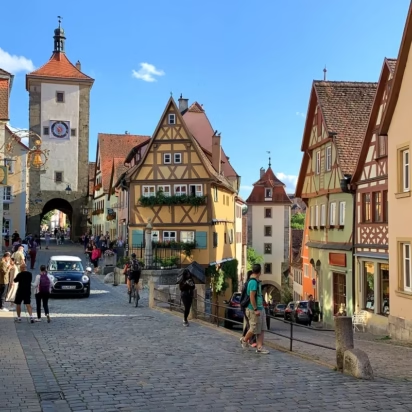The Holy Blood Altar (Heilig-Blut-Altar) by Tilman Riemenschneider in the St. Jakobs-Kirche (St James Church) is a top sight to see in Rothenburg ob der Tauber in Germany.

Tillman Riemenschneider’s Holy Blood Altar is one of the artistic highlights on the Romantic Road in Germany. It is also one of the most important medieval artworks in Germany. The monumental Heilig-Blut-Altar, created around 1500 for the St. Jakobs-Kirche (St James Church), remains a top sight to see in romantic, wall-encircled Rothenburg ob der Tauber. It is the only Holy Blood relic in any Lutheran church in Germany but the artistic quality of the woodcarving is by far the major attraction for modern visitors.
Tilman Riemenschneider Holy Blood Altar in Rothenburg
The Holy Blood Altar (Heilig-Blut-Altar) was ordered by the town council in Rothenburg ob der Tauber in 1499 as a more impressive showcase for the monstrance containing the town’s much-venerated Holy Blood relic. Tilman Riemenschneider, the famous sculptor and woodcarver from Würzburg, received the contract to carve the statues for the altar while a local craftsman, Erhard Harschner, made the basic frame and structure.
By 1505, the Holy Blood Altar (Heilig-Blut-Altar) was completed and installed in the bright Holy Blood Chapel in the well-lit western apse of the High Gothic St. Jakobs-Kirche (Church of St James). It stood 9.7 m (32 ft) tall and like the windows behind it, and the pillars of the church, seemed to soar to heaven with a slender frame structure quite unlike the more solid altars of the time.
Today, visitors still stream to the St.-Jakobs-Kirche, as Rothenburg is the top destination on the popular Romantic Road (Romantische Straße). The Holy Blood Altar is a highlight of German art.
Even though the St James Church has been Lutheran for nearly 500 years, and most visitors come to see the art, the Holy Blood relic remains in place in a cross reliquary on top of the altar. It is the only Holy Blood relic on display in a Lutheran church in Germany.
Holy Blood Altar (Heilig-Blut-Altar) in the St-Jakobs-Kirche
The Holy Blood Altar (Heilig-Blut-Altar) by Tilman Riemenschneider is in the western apse of the St. Jakobs-Kirche (Church of St James) in the old town of Rothenburg ob der Tauber. Like the church, the altar is High Gothic but with hints of mannerism. It marks the end of the Middle Ages and the beginning of Renaissance art in Germany.
Riemenschneider carved the statues for the altar from lime wood. The altar was never painted or gilded — unusual for the period but often the case with Riemenschneider’s work. He succeeded in creating carvings of such high quality that it was unnecessary to paint in details such as facial expressions and emotions afterward. This was also economical for the patron, as the painters were often far better paid than the sculptors.
The events depicted on the Holy Blood Altar are familiar to anyone with a basic grasp of Christian theology of any denomination. The chronological order of the story is read center level from left to right and then from bottom to top: Christ enters Jerusalem, the Last Supper, and the night in the Garden of Gethsemane / Olive Mount. A surprisingly small Crucifixion at the bottom, then a reliquary in the form of a Latin metal cross above the main altar, with a Christ of Sorrows / Mercy at the top.
Reliquary of the Holy Blood in Rothenburg ob der Tauber
To make sense out of the Holy Blood Altar, the reliquary is a good place to start, as it is the entire reason for the altar’s very existence. The reliquary is a metal cross with a rock-crystal capsule at the center that contains the Holy Blood.
It dates from around 1270 but by the end of the 15th century, the church desired a more suitable display cabinet for this treasure.
The contract Tilman Riemenschneider received for creating the Holy Blood Altar in 1501 was very specific about this part of the altar. The cross had to be mounted on a column held in place by two kneeling angels. On their sides, a depiction of the Virgin Mary and the angel Gabriel announcing an angelic greeting.
At the very top is Christ, depicted as a Schmerzensmann (Man of Sorrows), as is very often used on such large altars. Christ, although martyred and with the signs of the stigmata, had risen and ascended to heaven, in stark contrast to the depiction of the crucifixion lower down.
This upper superstructure (Gesprenge) is easily explained but the rest of the altar is less obvious.
Why is the crucifixion at the bottom and the Last Supper center, rather than the more conventional reverse order?
To fully appreciate symbolism, it is important to understand the origins of the Holy Blood relic.
Origins of the Holy Blood Relic in Rothenburg
The Holy Blood in Christian theology obviously refers to the blood of Christ. Looking at for example any Fra Angelico painting of St Sebastian and the Crucifixion, or simply the main altar in the front of this church, makes it clear that a lot of blood was shed. According to legend, Joseph of Arimathea cleaned the blood off the body of Christ but this blood is now claimed to be in the Heilig-Bloedbasiliek in Bruges, Belgium.
The Holy Blood in Rothenburg is about the Eucharist, which explains why the Last Supper, which was also the first Eucharist or Holy Communion, is at the center. However, it has nothing to do with the Holy Chalice or the Holy Grail. It is far simpler, and more complicated at the same time.
According to the Roman Catholic doctrine of transubstantiation, in the Eucharist, the wine literally changes into the blood of Christ. Thus when in around 1270 a local priest spilled some wine during the Eucharist, it was unthinkable to simply wash the “blood of Christ” out of the cloth. This Holy Blood was preserved in a vial. Whether the intention was to use it at a later communion or what was planned with it is unknown.
Miracles Attracting Pilgrims to Rothenburg ob der Tauber
However, soon miracles started to happen in the presence of the blood. In medieval Europe, such events quickly led to pilgrimages (and money). The relic of the Holy Blood was placed inside a rock-crystal container at the center of a gemstone-encrusted gilded monstrance shaped like a Latin cross. It is this reliquary that required a new “presentation case” at the turn of the 15th century.
→ See also the Marienaltar in the Herrgottskirche in nearby Creglingen, where a miracle host (communion bread wafer) went from chance discovery to papal permission to sell absolution indulgences in less than two decades. Riemenschneider carved the Altar of the Virgin Mary for Creglingen after he had finished the Holy Blood Altar in Rothenburg.
Last Supper in the Riemenschneider Holy Blood Altar in Rothenburg

For this reason, the first Eucharist is central in this altar, while the Crucifixion is at the bottom. In contrast, the high altar at the other end of St James Church follows the more conventional layout.
The Last Supper carving by Tilman Riemenschneider is a masterpiece. The sculptures of the disciples are all between 116 and 134 cm (46 to 53 in) high.
Riemenschneider carved each disciple with an individual face, clear expressions, and distinct features. All have curly, or at least wavy, hair. Somewhat surprisingly, four are shaven — customary, only John is left beardless. John seems to be sleeping through it all — he can only be seen from certain angles and is often hidden behind Judas.
James, the patron saint of this church, wears his customary pilgrim’s hat — even indoors and at the dinner table. He is placed in the corner where this is obvious but less distracting. The details are astonishing despite woodworms leaving some pockmarks.
Judas in the Riemenschneider Holy Blood Altar in Rothenburg
In contrast to almost all depictions of the Last Supper, Christ is not in the physical center but rather Judas, who already seems to carry his bag of 30 silver coins.
The reasoning behind this positioning has been much debated. Does it show the randomness of God’s mercy? It could happen to anyone. It also shows Christ still offering the Eucharist to Judas. Even though he knows Judas will betray him within hours, Christ still extends his mercy. Pilgrims looking at the altar should contemplate the mercy of Christ and how they treat their neighbors and strangers, as St James was on the popular pilgrim route leading to Santiago de Compostela.
Behind the disciples, the altar has its own glass rear windows — something that becomes very obvious when seeing the altar from the back. Intricately carved intertwining vines form a canopy, which is repeated in a simpler form at the top of the wings.
Wings of the Heilig-Blut-Altar
On the left wing is Jesus riding on a donkey into Jerusalem. His disciples follow, including beardless John and James with his hat. Someone throws his coat down to pave the road. Note the details on the band at the bottom of this coat, and those of the other city dwellers. In a tree is Zacchaeus — famous from an earlier Biblical story (Luke 19:3).
On the right wing is the night in the Garden of Gethsemane / Olive Mount. At the center is Jesus praying while the three disciples accompanying him have fallen asleep. In the background, Judas is approaching with the mob. Judas carries the bag with money in his left hand, which is fortunate, as he has lost his right hand sometime during the past five hundred years.
The outsides of the wings are plain. Although it was possible to close the altar, this was rarely done. It was supposed to be always open and not opened and closed according to the church calendar, as is sometimes done with other triptych altars.
Heilig-Blut-Altar in St.-Jakobs-Kirche Rothenburg
The Holy Blood Altar is in the Holy Blood Chapel at the far western side of the Church of St James (St.-Jakobs-Kirche) in Rothenburg ob der Tauber.
This part of the church was built over the busy street below and is 32 steps higher than the nave.
The light is best around noon, especially to see how the highlights and shadows change with the moving sunlight. Afternoon light through the large western windows may make it more difficult to see the details of the altar.
Tour groups often crowd the area but generally move along fairly quickly. Furthermore, the altar is quite high up, making it easy to see even from a distance, and when groups stand close to it.
→ See Visiting the St James Church with Riemenschneider Holy Blood Altar for more details and opening hours of the St.-Jakobs-Kirche in Rothenburg ob der Tauber.
Tilman Riemenschneider:
Who Was Tilman Riemenschneider?
Tilman Riemenschneider (c. 1460 – 1531) was a German sculptor and woodcarver working mostly in the Würzburg region (Northern Bavaria in modern political geography). He worked in both stone and wood but his lime-wood carvings, especially exquisite large unpainted altarpieces, are his best works. Written records on his life are rare and nonexistent on his thoughts or feelings.
Riemenschneider came from a relatively modest background but worked himself up (and married well, four times) to owning a workshop with 40 employees, several properties including his own wine farm, and a seat on the town council. His downfall was his misfortune to be mayor of Würzburg and a senior town councilor during the Peasant Revolt. He supported the peasants against the ruling prince bishop in 1525 and once the bishop restored order, Riemenschneider was imprisoned for a few months and lost much of his wealth. He produced no known new works during the final six years of his life leading to speculation that his hands were broken under torture.
Riemenschneider Revival
Following his death, Riemenschneider was soon forgotten. He was out of political favor and taste in art changed. In contrast to his contemporaries in the Free Imperial City of Nuremberg — such as Albrecht Dürer and Veit Stoß — he would only achieve fame long after his death. A chance discovery of his grave near Würzburg Cathedral in 1822 led to renewed interest and appreciation of his skill.
Neil MacGregor, former director of the National Gallery and British Museum, considered the intensity and subtlety with which Riemenschneider exposed the spiritual comparable to Donatello.
Julian Chapuis, director of the Bode Museum in Berlin, considered his ability unsurpassed in the control of the chisel to create expressions in a woodcarving that will remain unpainted.
Riemenschneider is never theatrical. His art does not shout. It articulates convincingly and softly. We recognize our hopes, our weaknesses, our aspirations … His talent resides in making God approachable on a personal level and in that sense he is, if you want, a Reformation artist, even though he worked for the Catholic Church all his life.”
Chapuis: Quoted in Germany — Memories of a Nation by Neil MacGregor (quite an interesting read.)
See Riemenschneider Art in Germany
Some of Tilman Riemenschneider’s works include:
- Altar of the Virgin in the Herrgottskirche in Creglingen
- Altar of the Holy Blood in the St.-Jakobs-Kirche in Rothenburg ob der Tauber
- Altar of Mary Magdalene — copy in Münnerstadt but the original is now split up and pieces spread over several museums including the Bode Museum in Berlin.
- Sculpture of Bishop Rudolf von Scherenberg in Würzburg Cathedral
- Emperor’s Tomb in Bamberg Cathedral
- A few works in Würth Collection and Johanniterkirche in Schwäbisch Hall.
- A sandstone Virgin Mary in the Liebieghaus Museum in Frankfurt.
- Adam and Eve – copies outside the Marienkapelle in Würzburg. The originals and
- More than 80 works are in the Mainfränkischen Museum in the Marienberg Fortress in Würzburg.
- St Elizabeth and Lamentation of Christ in the Germanisches Nationalmuseum in Nuremberg (Nürnberg).
More on Rothenburg ob der Tauber
For more on the Rothenburg ob der Tauber and nearby sights on the Romantic Road:
- Top Sights on the Romantische Straße with Romantic Road Map
- Walk on the Ramparts and Sentry Walk on the Wall of Rothenburg
- Visit the St.-Jakobs-Kirche (St James Church) with the Tilman Riemenschneider Holy Blood Altar
- Visit the Medieval Crime Museum
- Visit the Wolfgang’s Church in the Klingenbastei
- See the Herrgottskirche with Tilman Riemenschneider Altar of the Virgin in nearby Creglingen
- Transportation to Rothenburg ob der Tauber – Driving or Take the Train
- Bus Day-Trip Tours are often available from Frankfurt or Munich.
- Hotel prices in Rothenburg are surprisingly reasonable, except over weekends.
- Save with the Bayern-Ticket on Train Transportation in Bavaria
- Get online quotations for taxis and airport shuttles from Frankfurt or Munich airports.
